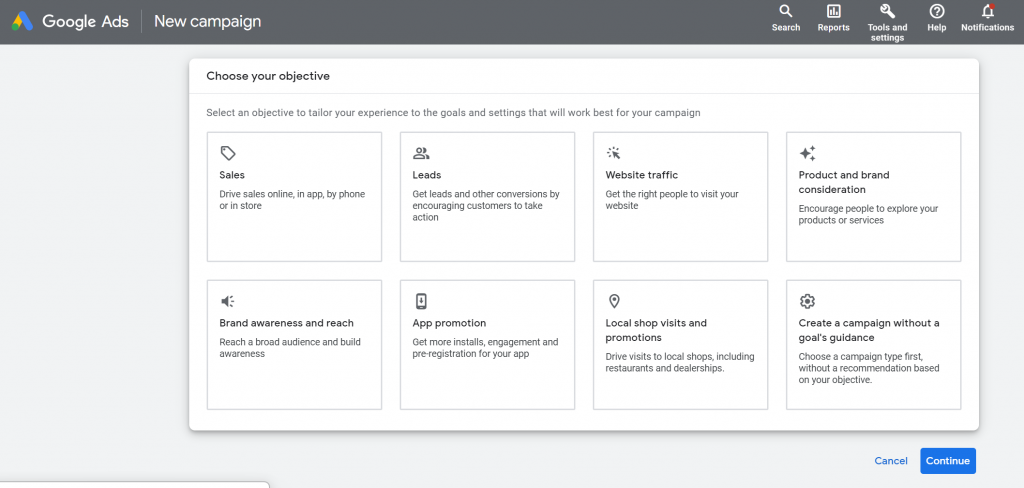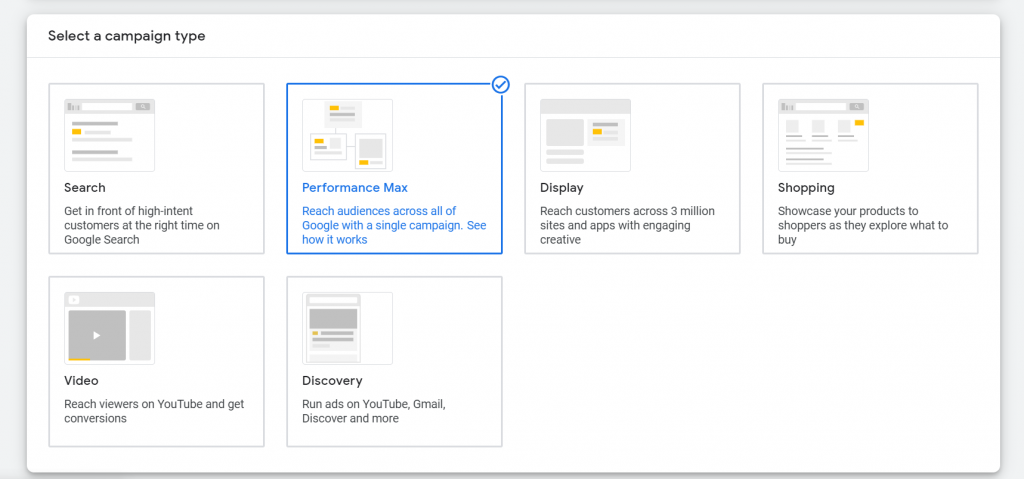Google Ads Performance Max: Is it any good?
In November 2021 Google launched Performance Max, a new and largely automated campaign type designed to help advertisers gain maximum reach and exposure, across all Google Ads inventory and channels, in the most efficient way possible. While it’s a new and distinct offering, it has also been built to replace Google Smart Shopping.
Google’s goal with Performance Max was simple: help advertisers use automation to maximise advertising impact, and in turn maximise conversions and business growth.
While Performance Max started as an unknown quantity – like most Google products, it’s somewhat of a black box, with the inner workings remaining a closely guarded secret – we now have enough user data to understand how it works, what it’s good for, and whether it might be of use to you.
Are Google Ads Performance Max campaigns any good? Here’s all you need to know.
What is Google Ads Performance Max?
Google describes Performance Max as “a new goal-based campaign type” built to complement traditional keyword-based search campaigns. Its reason for being is to help advertisers like you to find and convert more customers right across the Google ecosystem.
This form of search campaign is designed to be fast, intense, all-encompassing and super impactful. In the space of a few short minutes and a handful of clicks you can get a campaign set up that targets your ideal audience by simultaneously securing a vast array of Google advertising placements:
- PPC ads: Be seen at the top of the search engine results page (SERP).
- Display ads: Secure space across websites on the Google Display Network.
- Shopping ads: Get your products featured under the ‘Shopping’ tab within Search.
- YouTube: Get featured in pre-roll ads on videos watched by your ideal audience.
- Gmail: Secure space at the top of your audience’s inbox without having to send a single email.
- Maps: Put your name up in lights for local search queries by getting featured on Google Maps.
- Apps: Secure space across apps on the Google App Network.
On its release, Google promised that Performance Max would offer increased automation, deeper insights and better campaign performance. As the name suggests, it sole goal is to maximise performance.
In the quest to achieve these outcomes Google has leaned heavily into machine learning, which always brings with it some limitations in terms of control: bids, campaign tweaks and even the production of creative assets are to some degree automated within Performance Max, which beginners will find amazing, but more tech-savvy advertisers may find frustrating or disconcerting.
But is a Performance Max campaign right for you? To find out, we need a better understanding of how Performance Max works.
How do you use Performance Max?
The biggest difference between a Google Ads Performance Max campaign and a more traditional keyword campaign is in Performance Max’s use of machine learning and automation.
When you set up a campaign Performance Max asks for a few basic pieces of information; things like your goals for the campaign, your target metrics and your budget. It then punches these data points into its machine learning algorithm, which decides how the ads will be delivered to your audience (in terms of channel, timing, frequency and more) and how much you’ll pay (using the Smart Bidding system).
Because Performance Max uses machine learning, using data like audience signals to constantly enhance and optimise every single element of every single campaign, Google claims that it will perform better and better as each campaign rolls on. While one of the main selling points is efficiency, the very best results are likely to come after a month or two.
It should also be noted that no Google Ads campaign, even one as apparently clever as a Performance Max campaign, should be left to its own devices. If you set and forget, you might find that the Google algorithm has taken your campaign in a direction that you neither expected nor particularly wanted.
You instead need to stay involved in a Performance Max campaign to ensure it does what you want it to do (read more about smart strategies to maximise Google Ads performance here!) Sure, it will generally involve less work than a traditional Google Ads campaign, but that doesn’t mean no work.
How do you set up a performance max or pmax campaign? If you have a Google Ads account and use Google tools semi-regularly, it’s a fairly straightforward process:
- Click on ‘New Campaign’ to get started.
- Choose your campaign objective, whether sales, leads, website traffic or anything else (you can also create a campaign without a specific goal, though this isn’t recommended).
- Select the ‘Performance Max’ option and give your campaign a name.
- Nominate a budget and choose a bid strategy that aligns with your goals.
- Select your campaign settings with your target audience in mind.
- Create an asset group, then provide Google with the creative that it can use to automatically generate display ads.
- Provide ad extensions (key info about your business).
- Review your campaign summary, then click ‘Publish Campaign’.
If you’re a seasoned user of the Google advertising suite, Performance Max basically functions as a cross between Smart Shopping (which it replaced) and Dynamic Search Ads.
If you aren’t a seasoned user, don’t fret: the automation on offer makes Performance Max a relatively simple tool to use, though it will always perform best in skilled hands. (It also might be worth checking out our beginner’s guide to Smart Campaigns.)
The pros and cons of Performance Max (Our Review)
So, is it any good? To understand whether Performance Max is the right tool for you, let’s take a look at the advantages and disadvantages of the system.
Performance Max pros
Performance Max promises to deliver advertisers better results – more impressions, reach, engagement and conversions – in quicker time. It does this through:
- A focus on goals: A major strength of Performance Max is in the way it forces you to define your campaign goals from the get-go, ensuring every campaign has a purpose and that each is focused on conversion.
- Making omnichannel easy: Performance Max grants your advertising the opportunity to be presented across entire Google network – Search, Display, Shopping, YouTube, Apps, Maps and more. This ensures you get your brand in front of the right people at the right time, no matter where they might be.
- Automation: The outward simplicity of Performance Max hides its deeply clever and complex inner workings. Campaigns can be set up in a few simple steps, before the algorithms take over and continue to improve performance over time.
- Smart bidding: This automated simplicity extends to the bidding process. Smart bidding takes care of all aspects of the ad buying process, getting you the best deal possible on the online real estate you need.
- Automated asset creation: In a tool loaded with clever features, this might be the smartest of the lot. Offer up creative assets to Performance Max and it can generate ads for you!
- New and improved insights: Performance Max brings a number of new insight-specific features, including asset audience insights, which measure customer responses to the content of your ads and divide them into segments, and diagnostic insights, which help you troubleshoot campaign issues.
- Audience signals: These signals provide information that you can use to target your ads more effectively. They help you to point Performance Max’s machine learning technology in the right direction.
- Rolling the best of Google into one: Before Performance Max came along, a digital marketing expert would need to lean on four or five Google campaign tools to get the same job done – Discovery, Display, Dynamic Search, Smart Shopping and potentially Video.
Performance Max cons
The features above paint an alluring picture of Performance Max… but it can’t all be sunshine and lollipops. Depending on who you are, what your goals are and how you aim to use the tool, there may be some drawbacks:
- A reliance on firm goals: Often ad campaigns exist to test the water, then take a more defined shape as you begin to get feedback. Performance Max isn’t built for these types of campaigns, as it works best when you offer up firm goals from the very start. If you’re not crystal clear in your conversion goals, you may not get great results.
- Limited reporting: As mentioned above, Performance Max places a simple bonnet over an incredibly clever and complex engine. This is one of many Google products that is a black box – you don’t see much of what’s going on inside. Deep and specific insights can therefore be hard to come by. You can’t, for example, see the specific channels that traffic is coming from, or get channel-by-channel performance figures. These features may be offered at some point, but they’re not available yet.
- An over-reliance on automation: Performance Max automates campaigns wherever possible, sometimes to the advertiser’s detriment. If you don’t keep a close eye on your campaign you could find it drifting off to odd places, as the machine learning model chases what it sees as wins, but that may not align with your specific wants and needs.
- A lack of control: Further to this deep automation, you won’t enjoy as much control with a Performance Max campaign as you will with a traditional campaign. If you’re a highly skilled user you will certainly find the tools more efficient, though it may not guarantee the best performance.
Should I use Performance Max?
So, is Performance Max right for you? Generally speaking the tool is great for:
- Campaigns with specific goals: If you have clear-cut conversion goals, Google’s machine learning algorithms offer a fantastic means to achieve them.
- Flexible campaigns: If your campaign isn’t weighed down by time, budget and resource constraints, and if you have the flexibility to test and see what works best, Performance Max is ideal.
- Omnichannel campaigns: Granting you instant and automated access to every Google platform, Performance Max is an incredible tool for omnichannel campaigns – it’s an all-access Google pass!
- Enhancing keyword search campaigns: With powerful machine learning on your side, you’ll reach even more people and enjoy even more conversions.
- Those with the right skills: While Performance Max brings high-end digital advertising performance to a wider audience, you’ll still need a decent level of skill to get the most out of it and to ensure you’re not wasting money.
This last point is why most organisations hand the responsibility for their online advertising efforts over to experts. Like any specialist tool, the power of Performance Max is only really unlocked when it’s placed in the right hands.
At Traction Marketing we have spent years helping Kiwi businesses capitalise on digital marketing. We help you to identify your audience, understand your niche, and use high-end tools like Performance Max to get the greatest results possible.
Ready to maximise your advertising performance with Performance Max? We’re ready to help. Get in touch with our friendly team today.










